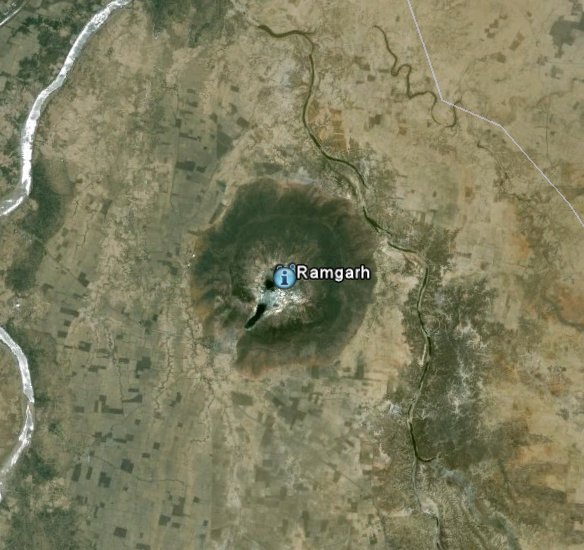
Спутниковая фотография района кратера из Google Earth. |

Спутниковая фотография района кратера из Google Earth. |
Кольцевая структура Рамгарх в р-не Кота в Раджастхане является обособленной, почти строго круговой формой, хорошо заметной в области развития песчано-глинисто-карбонатных отложений надсерии супергруппы Виндхья (средне-верхнепротерозойской). Внешний диаметр структуры - 4 км, внутренний - 2 км, площадь - 16 км{2}, радиус - около 3 км, отношение глубины к диаметру - 0,05. Высота внешнего кольца около 200 м, макс. - 240 м. В центре имеется поднятие с небольшим конусом. Результаты бурения и геофизических исследований позволяют отказаться от предложений о связи структуры с телами кимберлитов, карбонатитов и др. магматических тел, также как и о связи с куполообразной складкой. Все это свидетельствует о ее возможной импактной природе. Принадлежность ее к астроблемам требует тем не менее дополнительных доказательств и, прежде всего, признаков шокового метаморфизма (наличия коэсита, импактных брекчий или расплавов и т. п.), которые могут быть получены в процессе дальнейших исследований.
(Nayak, 1997).
For long, the crater was believed to have an impact origin. However, convincing shock metamorphic features or
geochemical indicators were missing. In 2021, Agarwal and his coauthors reported planar deformation features and feather features to
establish its meteoritic impact origin. Ramgarh impact structure formed in upper Vindhyan sedimentary rocks, perhaps during the middle
Jurrasic age. The crater has an apparent diameter of 10 km, which is constrained by large scale low angle normal faults, and the collar is
200 m high and 3.5-4 km wide. Arguably, the most remarkable feature of the complex impact crater is its 200 m high and 3.5-4 km wide
annular collar. Within the collar, the central depression is covered by soil with an underlying sequence starting at the top with Ganurgarh
Shale and followed by other underlying shales, siltstone, and sandstones belonging to the Rewa and Kaimur Groups of the Upper
Vindhyan
(Agarwal, 2022).